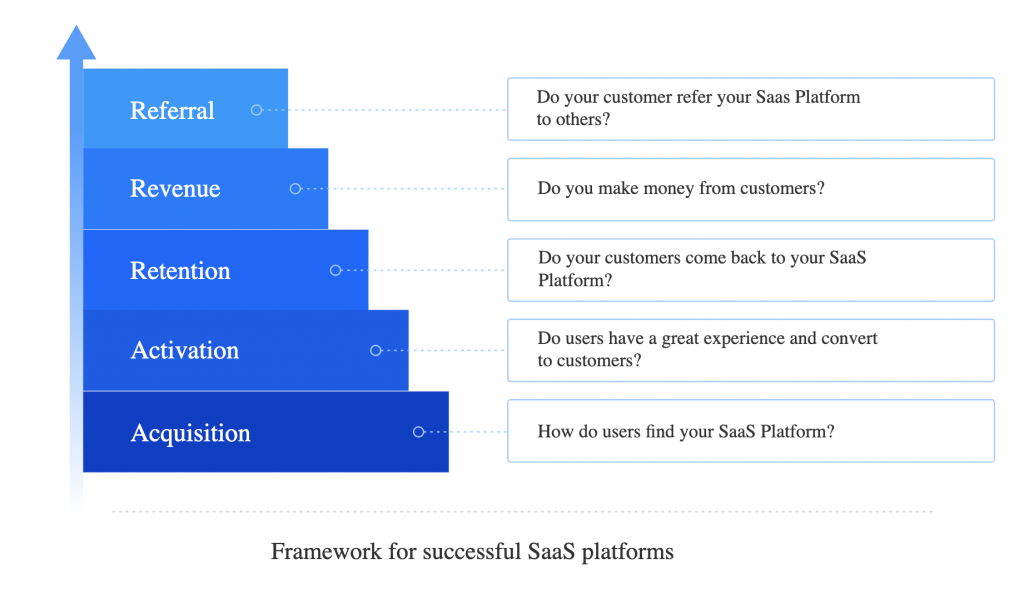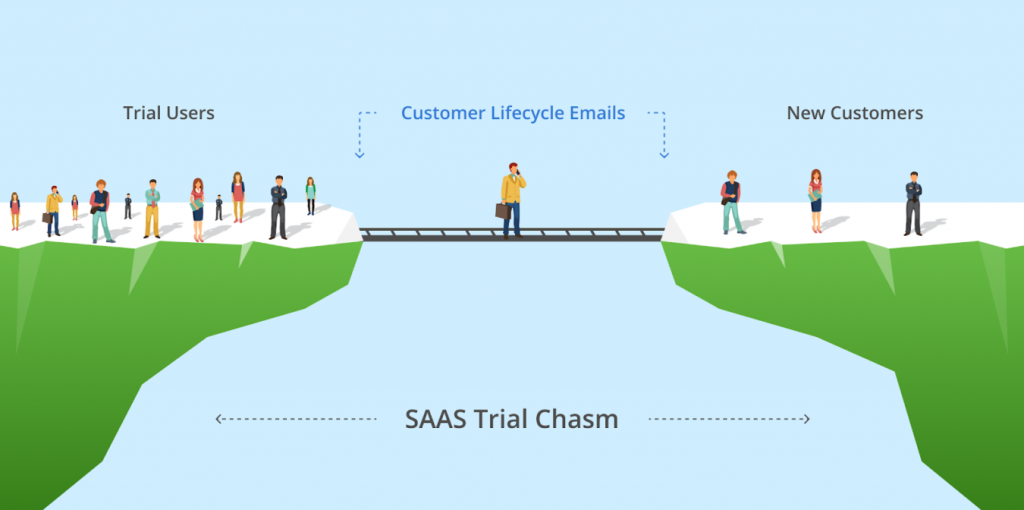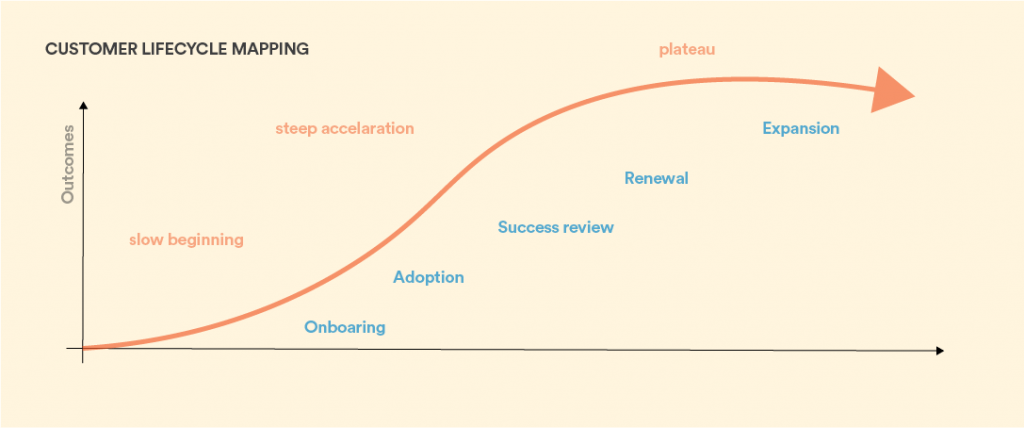Guide To SaaS Customer Lifecycle
Attracting customers to your business is very important. But it doesn’t end there for a successful business. You need to make sure that the interaction with customers will not be a one-off. Only in this manner can you increase the number of customers you interact with on a daily basis, get rid of the slew of businesses that are unable to grow quickly enough, and move to the bright side.
First of all, to establish an efficient relationship with your customers, you need to be able to effectively interpret the customer interaction process with your business, namely the SaaS Customer Lifecycle.
What is SaaS customer lifecycle?
The SaaS customer lifecycle is the process that encompasses all the steps from a customer’s first engagement with your business to a happy ending. In other words, it refers to the procedures that lead to potential customers learning about your business and the product or service you offer, interacting with it, and making a purchase. Knowing when customers will come in when they will leave, and how much time they will spend in your business is crucial to determining your policies going forward. All stages of a customer’s lifecycle journey are vital to converting customers into repeat buyers. To build positive customer experiences, you must prioritize your relationships with customers. So, it’s critical to take customer lifecycle management seriously and act according to a plan. Here are six steps you can take to ensure customer satisfaction at each stage of the customer lifecycle.
#1 SaaS Customer Lifecycle Stage: Awareness
The first step is to raise awareness for the problem. To begin this phase, you must persuade the buyer to look for a specific product or service. Then, using various methods such as social media advertising, strategic content for SEO, blog articles, and so on, you must enlighten customers about the product or service you are offering. It essentially entails informing potential clients that they have a problem and informing them that the solution you provide through a service or product can assist them. We don’t always see problems or deficiencies as such until we discover that there is a solution. So, if there’s anything as significant as coming up with a solution to a problem, it’s making sure that potential customers are aware of it.
Creating the right awareness is very important. Simply put, creating the right awareness means accurately identifying the questions of your customers and offering solutions to these problems in an effective and original way. Undoubtedly, social media will be one of your biggest weapons in this regard, with the fast and effective interaction opportunities it offers.

#2 SaaS Customer Lifecycle Stage: Conversion
Once potential customers have passed the first stage and shown interest in your product or service, they start evaluating what they want, eliminate what they don’t want, and ensure that they can afford the service or product they are purchasing. At this point, you need to connect customers to your business by providing accurate and satisfactory assistance to those who are considering testing your product. This is usually when a customer is given a free trial of a SaaS product. The aim here is to show the customer exactly the services you can offer and to prove the value of your services. At this stage, you need to educate the customers you attract about the product or service they are considering to buy. Explain to them how to use the fundamental features and how to get the most out of your product or service in detail and simply. This can be accomplished in a variety of ways. Some examples include anecdotal how-to videos integrated within the application, courses given by expert educators, how-to guides, and online help centers. Help them overcome their initial hesitations.By helping potential customers with making decisions, you’ll be one step closer to converting them into committed customers.
#3 SaaS Customer Lifecycle Stage: Purchase
Congratulations, here is a new customer!
Your product has been purchased by the customer. The potential customer turned into a real, fee-paying customer. Still, remember that even if you’ve come a long way, the journey has only just begun.
We can divide customers into three groups:
First time buyer who complete their first purchase transaction on your site
Retained customers who have made more than one transactions
Loyal customers who have completed more than 3 transactions and have also performed transaction for more than 6 months.
Now your goal is to add the new first-time buyer to your list of loyal customers.
#4 SaaS Customer Lifecycle Stage: Activation
You’ve reached the most arduous phase of the challenge. It is your turn to make sure that the customer to whom you are selling your product is in an active relationship with your business. Customers that make one-time purchases in your subscription-based business do not secure your business. You constantly face the danger of losing a customer to your competitors if you can’t prove the value of the service you provide or if you can’t provide the service that will satisfy your consumer. Therefore, the sale you make never ends. You should always support your customers and make sure that your interactions with them are healthy. Preventing customers from experiencing any ambiguity by creating an excellent customer service experience should be your primary goal. By using product usage analytics, you can measure the activities of your customers and set a strategy accordingly. One of the most effective actions you can take in this regard is to provide customer service shortcuts or windows on your website that customers can access quickly and effortlessly. In this way, any possible complications are swiftly and smoothly resolved, and the feedback you collect becomes a direct and reliable source for your feedback database. The most important thing is to build the customer’s sense of belonging as much as possible, ensuring their commitment to your business. Determining whether they will renew their subscription when it expires, in a way, determines the future of your business. The important thing is to make a good first impression of your new product and company. Only in this way can you avoid losing frustrated and unsatisfied customers to your competitors. You can make
- instructional videos
- customer surveys
- send an email or text message as a welcome message.
#5 SaaS Customer Lifecycle Stage: Renewal
After you get your customer used to your product and adopt its use, you should start making plans for the future. In order to renew contracts in a subscription-based business model, you must have established strong customer relationships. For this, the period after the first purchase is very important. It’s not enough to be part of the customer’s daily routine, you must also refine that routine until it becomes indispensable. So you need to encourage product addiction. Deepen usage, constantly remind how useful your service and product are.
You can use the following strategies to boost customer renewal rates:
- Prevent Inadvertent Churn
Credit card payment failures are a common cause of involuntary churn from SaaS enterprises. Customers who wish to renew their personal or business credit cards may forget the expiration date or fail to update the card on file. Most credit cards expire every three years, which means that 33 percent of memberships could be cancelled each year due to payment methods that have expired. Customer data should be reviewed periodically in your CRM, and customers should be notified when their payment source is due to expire. - Offer incentives to renew memberships.
Because it is “too expensive,” some customers prefer not to renew their annual or monthly membership fees. Offering incentives for renewals is one approach to getting through this obstacle. You can get discounts for renewals in addition to discounts for new customers. - Make payment and renewal as easy as possible
A subscription that can be renewed in one click or in a few steps is always more useful. Most of your customers who forget to renew their subscriptions postpone it because they think this process will take time and then they forget it completely. Provide a fast and secure payment method and make renewal steps as short and direct as possible. - Remind your customers of your service’s benefits.
It’s critical to demonstrate your value throughout the year and persuade your customers that they’re getting their money’s worth. Make your consumers aware of the value you bring to the table. Furthermore, by sending various surveys to users, you may determine whether you and your users agree on your value, as well as assess and alter the benefits you provide based on the information you receive.
#6 SaaS Customer Lifecycle Stage: Referral
Now that your customers have renewed their relationship with your business, we can say that they are now happy and committed customers. Customers who are satisfied with your service become customer advocates. These people, who want to share their happiness and satisfaction, are an invaluable resource for expanding your business. Get feedback from renewed customers on why they chose to renew so you can maximize customer renewal. You can use NPS surveys for this. In this way, you can determine the strategies you will use to attract more dedicated customers and determine which strategies work and which do not. When you get to the customer loyalty stage, you can thank your customers for it in a number of ways. For example, you can give them small discounts or offer useful promotions in exchange for their helpful feedback. Here are some suggestions to get more referrals:
1. Make referencing as simple as possible.
Despite your best efforts, even the most loyal customers may not be receiving your promotions. Even if they are frequent visitors, don’t assume that customers purchasing on your site are aware of your referral program. You don’t want to make people go looking for your referral program on your website if they already know about it. Rather than hiding the program information in a dark corner of your website, make it stand out. On your homepage, include a button or tab that invites customers to join your program and get the rewards. Customers are more likely to refer someone if the program is prominently displayed.
2. Interact with your customers on social media.
By conversing with your customers, participating in product discussions, answering questions, and assisting with problem-solving, you establish an active presence not only on social media but also in the lives of your best customers. Customers are considerably more likely to recommend a company if they feel personally connected to it, and social engagement is the ideal way to foster that sense of personal connection and trust.
3. Don’t be afraid to ask your customers for referrals.
If you have a useful and valuable service and a reasonable follow-up strategy, do not be afraid to ask your customers accordingly. For example, you can remind your customers of this via a general e-mail or you can ask them directly to talk about your business to one or more of their contacts .
Conclusion
Understanding your customers’ demands and needs is critical to attracting new customers and keeping current ones. Knowing where your clients are in the customer lifecycle allows you to develop effective strategies and provide valuable assistance to them throughout the experience. These six stages I have mentioned will allow you to effectively evaluate customer feedback and, as a result, establish more reliable customer loyalty. Check out HockeyStack for additional information on managing and tracking your customers throughout their lifecycle.
FAQ
Defining your customers’ personality by collecting data such as age, gender, location to determine your target audience will be a good start for you to determine the right strategies. You can send surveys to your current customers to understand what motivates potential customers to buy your product. Then, in the light of this information, design an effective customer experience vision.
In short, it is a set of steps that cover the stages of a customer becoming a committed customer. These are the steps of discovery, persuasion, purchase, activation, renewal and referral.
The marketing lifecycle is a method for positively influencing a prospect’s or customer’s behavior in favor of your business by utilizing every potential touchpoint during the lifecycle. You can convert prospects into purchases, loyal customers, and brand ambassadors by recognizing your audience’s diverse needs and meeting them with the right information at the right time.





